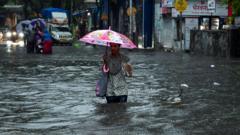Heavy rains struck Mumbai last month before the monsoon season even formally began, leading to widespread flooding that stranded residents and brought the city to a standstill. Photos and videos of waterlogged streets and a submerged new metro station circulated on social media, intensifying public anger regarding the city’s infrastructure failures. The Brihanmumbai Municipal Corporation (BMC), one of the nation’s wealthiest civic bodies, pointed fingers at clogged drains and debris from ongoing metro construction for the chaos. In response to the backlash, the BMC deployed de-watering pumps and began clearing drains, but many residents felt these measures were too little and too late.
The issue of urban flooding isn't confined to Mumbai. Cities from Delhi in the north to Bengaluru in the south are consistently plagued by similar monsoon-related disasters. Experts attribute these annual flooding crises to rapid urbanization, crumbling infrastructure, and a history of environmental negligence. "Infrastructure has not kept pace with urban growth," remarks architect and urban planner Dikshu Kukreja. Many cities depend on outdated drainage systems that were designed decades ago, exacerbated by the destruction of natural drainage channels and wetlands.
India’s reliance on the monsoon season, which delivers up to 80% of its annual rainfall between June and September, is vital for agriculture but poses severe challenges due to climate change. Seasonal weather patterns have become increasingly erratic, leading to disastrous consequences such as flash floods and droughts. The monsoon, which arrived a week ahead of schedule in southern India this year, caught local authorities off guard.
Delhi has come to symbolize this struggle, with annual flooding under structures such as Minto Bridge drawing media attention. With record-breaking rainfall of over 185 mm in May, residents experienced extensive property damage, and the toll included deaths and injuries due to the storm. Far from unique to the capital, Bengaluru is also grappling with flooding issues stemming from poor urban management. Once home to numerous lakes that helped absorb excess rainwater, the city has seen significant encroachment on these vital water bodies, replaced by buildings and roads.
Ram Prasad, a lake conservation activist, emphasizes that the mismanagement of these natural assets has left Bengaluru ill-equipped to handle increased rainfall. Urban planning violations, such as narrowing stormwater drains, have compounded the issue.
In Mumbai, geographical challenges further aggravate flooding when combined with poor urban planning decisions, which have led to the destruction of mangroves and building on floodplains. According to Kukreja, the problems stem from a lack of foresight in urban planning, coupled with insufficient enforcement of regulations, which results in reactive rather than proactive governance.
Smaller towns are also suffering, as evidenced by a recent disaster in India’s northeastern states that resulted in flooding and landslides, claiming at least 30 lives. Experts suggest a comprehensive approach is essential to mitigate flooding in urban areas. Kukreja indicates that real-time mapping and responsive governance, along with community involvement, are crucial components needed for effective long-term solutions.
Ultimately, addressing urban flooding challenges in India's cities requires more than quick fixes; it demands a strategic, forward-thinking approach to urban development designed to withstand the increasing volatility brought by climate change.




















